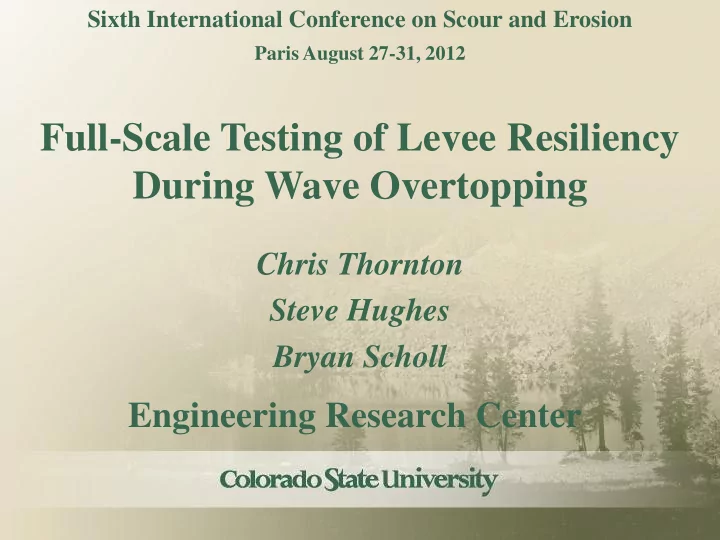

Sixth International Conference on Scour and Erosion Paris August 27-31, 2012 Full-Scale Testing of Levee Resiliency During Wave Overtopping Chris Thornton Steve Hughes Bryan Scholl Engineering Research Center
Project Overview • Requirements: – Simulate large wave overtopping discharges – Replicate New Orleans levee grass slopes – Test alternative slope protection products • Design Issues: – Overtopping simulator design – Planter trays to simulate soil/grass/TRMs – Operating procedures – Measurements
Principle of Wave Overtopping Simulation
Overtopping Distribution 6000 0.1 l/s/m 1 l/s/m 5000 10 l/s/m Overtopping volume (l/m) 30 l/s/m 50 l/s/m 4000 75 l/s/m 3000 2000 1000 0 0 100 200 300 400 500 600 700 800 900 Number of overtopping wave, in ascending order
Overtopping distribution 1200 1 l/s per m calculation overtopping volume per wave simulation 1000 (liters per m width) 800 56 waves with 50 l per m 40 waves with 150 l per m 600 10 waves with 400 l per m 6 waves with 700 l per m 3 waves with 1000 l per m 400 200 0 0 10 20 30 40 50 60 70 80 90 100 110 120 130 Number of overtopping waves in descending amount
Wave Overtopping Test Facility
Wave Overtopping Test Facility
Wave Overtopping Test Facility Physical Features • Full-scale testing • Dual test channels • Steady state capabilities • Flow measurements • Accommodate different tray geometries
Wave Overtopping Test Facility Hydraulic Features • Total simulator capacity – 27 m 3 or 15 m 3 /m • Average wave overtopping discharge 200 – 380 l/s per m (depends on wave period) • Corresponds to H m0 = 2.4 m, T p = 9 s • Steady overflow – 2.5 m 3 /s per m (or more)
Planter Tray Dimensions
Tray Preparation
Tray Cultivation
Tray Installation
Resiliency Testing Overview
Overtopping Simulator in Action Video
Bare Clay Slope Test Upper Tray Lower Tray After 1 hour at 9.3 l/s per m Before Total failure after 20 min at 18.3 l/s per m
Lime-Stabilized Bare Clay Test After 20 min at 370 l/s per m Before
ACB Slope Protection Tests New Orleans Clay Before After test at 370 l/s per m
ACB Slope Protection Tests Golden Soil Failure at 370 l/s per m
Grass Slope Resiliency Tests Bermuda Grass Slope No damage after 370 l/s per m After 12 hrs of testing
Grass Slope Resiliency Tests Bahia Grass Slope Before No damage after 280 l/s per m
Grass Slope Resiliency Tests Bermuda Grass with TRM Before No damage after 370 l/s per m
Grass with Wheel Ruts Before After test at 370 l/s per m
Dormant Grass Slope Resiliency Test After 1 st hour at 230 l/s per m At end of 3 rd hour After 2 nd hour at 185 l/s per m Before
Dormant Grass + Tight Weave TRM After 3 rd test at 370 l/s per m Before
Dormant Grass + Open-Weave TRM After 3 rd hour at max. of 140 l/s per m At end of 3 rd hour
Damage Quantification
Cumulative Loading vs. Duration
Dormant Grass Performance
ACB Slope Protection Tests Cumulative Loading ACB Soil Quality
ACB Slope Protection Tests Cumulative Loading ACB Soil Quality
Levee Slope Resiliency Testing Results • Healthy sodded grass surfaces did not fail • Damaged healthy grass surfaces survived at high loads • Dormant grass failed at reduced loads • HPTRM provided significant protection for dormant grass • Open-weave TRM provided little protection for dormant grass • Bare clay and lime-reinforced clay fail rapidly • ACBs effectively protected the underlying clay, but performance dependent on soil type
Levee Slope Resiliency Testing Lessons Learned • Dense roots and thatching are critical at high overtopping rates • Grass in planter trays was very good and most likely not representative of typical grass slopes • Robust test protocol has been developed and vetted • Soil type may be key to performance • Steady state loading results applied to wave overwash most likely very non-conservative
Lessons Still to Learn • Effect of variations in soil type • Correlation between steady and un-steady loading • Quantification of dynamic hydraulic forces • Significance of: • Wave conditions • Levee geometry • Vegetation species • Resiliency of grass reinforcement • Implementing cumulative excess work and hydraulic loading methodologies
Comments or Questions?
Recommend
More recommend